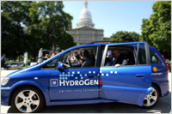
Are Latest Vehicle Engines Too Quiet for Pedestrians' Own Good?
Because blind pedestrians cannot locate and evaluate traffic using their vision, they must listen to traffic to discern its speed, direction, and other attributes in order to travel safely and independently. Bicyclists, runners, and small children also benefit from hearing the sound of vehicle engines, say two congressmen who are concerned that the silence from new vehicles that employ hybrid or electric engine technology render the vehicles extremely dangerous in situations where vehicles and pedestrians come into proximity with each other.
On Wednesday, U.S. Representatives Edolphus “Ed” Towns (D-NY) and Cliff Stearns (R-FL) introduced H.R. 5734, a bill intended to protect the blind and other pedestrians from injury or death as a result of silent vehicle technology. The Pedestrian Safety Enhancement Act of 2008 requires the Secretary of Transportation to conduct a study on how to protect the blind and others from being injured or killed by vehicles using hybrid, electric, and other silent engine technologies. Dr. Marc Maurer, president of the National Federation of the Blind, applauded the measure.
“The blind, like all pedestrians, must be able to travel to work, to school, to church, and to other places in our communities without being injured or killed," Maurer said. "This bill will benefit all pedestrians for generations to come as new vehicle technologies become more prevalent. The blind of America will do everything in our power to ensure its swift passage.”
Towns, who has experience teaching the blind to travel by cane, said the sound of traffic can be "critically important" for them to travel safely and independently. Stearns said he has heard some of the same safety concerns from senior citizens in his district. "The beneficial trend toward more environmentally friendly vehicles has had the unintended effect of placing the blind and other pedestrians in danger,” Towns said. “This bill will prevent many injuries and fatalities while still allowing more clean vehicles on our nation’s roads.”
H.R. 5734 requires the Secretary of Transportation, within 90 days of its enactment, to commence a two-year study to determine the best means to provide the blind and other pedestrians with information about the location, motion, speed, and direction of vehicles. Upon completion of the study, the Secretary will report the findings of the study to Congress and, within 90 days, establish a minimum vehicle safety standard for all new vehicles sold in the United States. Automobile manufacturers will have two years to comply with the vehicle safety standard.